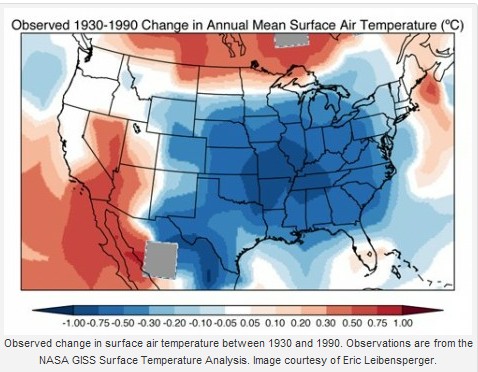Some geniuses at Harvard have determined that cooling in Wyoming and West Texas from 1930 to 1990, was due to particulate emissions on the east coast.
“What we’ve shown is that particulate pollution over the eastern United States has delayed the warming that we would expect to see from increasing greenhouse gases,” said lead author Eric Leibensperger, who completed the study as a graduate student in applied physics at the Harvard School of Engineering and Applied Sciences.
“For the sake of protecting human health and reducing acid rain, we’ve now cut the emissions that lead to particulate pollution,” he added, “but these cuts have caused the greenhouse warming in this region to ramp up to match the global trend.”
Before the Clean Air Act was passed in 1970, particulate pollution was prevalent in the air over the central and eastern states. Most of these particles in the atmosphere were made of sulfate, originating as sulfur emissions from coal-fired power plants. Compared to greenhouse gases, particulate pollution has a very short lifetime (about 1 week), so its distribution over the Earth is uneven.
Besides the geographical nonsense, there are two other fatal problems with this theory.
- A rapid reduction in particulates over land in the 1970s would have produced a step function in temperature, not a drawn out 40 year rise. There is no physical mechanism which could explain such a lag.
- Almost all of the reported warming in the eastern US since 1960 is due to upwards adjustments by USHCN. Thermometers don’t show much of an upwards trend.
ts.ushcn_anom25_diffs_urb-raw_pg.gif (650×502)
Strike three – another peer reviewed Ivy League joke.




Well, all that and the prevailing winds are west to east…….
At Harvard, you learn that it goes from east to west…… they’re really super smart sciency types there!
Do you think it was the inbreeding?
Now… models can be valuable, but there seems little point in publishing such results in journals. For journal publication a few very basic criteria should be met. What is the empirical support for the model? I.e., how does the model agree with temperature changes over time? And what does the model predict will happen in the short term? I.e., can we test this model?
If the paper makes no testable claims or is inconsistent with observational data, exactly why was this sort of thing published in the first place?
These bs artists are grasping at theoretical straws. From the ‘missing heat’ to explain the lack of warming, to tectonic land movements to explain lack of “observable” sea level rise. There is layer after layer of often contradictory theoretical mumbo jumbo that they scatter shot into the field with the hope that enough sticks with the public as the liberal MSM carries water for them so that their Frankenstein theory will continue to lumber forward.
For most of us there is something almost intuitive in us that senses the theoretical hogwash, even if we don’t have direct evidence of this (even though in most cases we do). There’s a sense that the temperatures are fine, the weather is normal, sea levels are unchanged and won’t change, and the whole CO2 hubbub is misguided. This is a great anti-AGW video they highlighted on hotair (http://hotair.com/archives/2012/04/27/video-the-love-of-theory-is-root-of-all-evil/) that talks about the danger (to humanity) springing from the Love of Theory. A must see:
http://www.youtube.com/watch?v=rnEsI2fTaJo&feature=player_embedded
Nice video.
One has to ask : is that graduate student’s name Leibensperger, or Asperger?
I like that they used the Nasa GCM model (regionally downscaled to North America – don’t tell Pielke Sr.) output to feed into the Harvard model.
So the result is modeled model. I’m pretty sure Feynman wouldn’t approve…